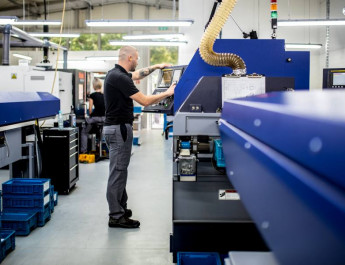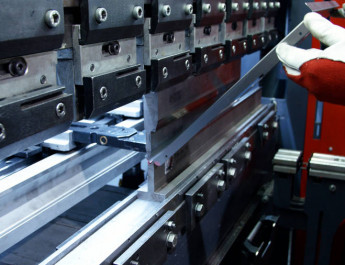Sheet metal is a versatile material that serves as the backbone of countless products and industries, from automotive manufacturing to aerospace and electronics. One of the key processes that have revolutionized the way we work with sheet metal is laser cutting. Laser cutting has become the preferred method for cutting and shaping sheet metal due to its precision, speed, and versatility. In this comprehensive guide, we’ll delve into the world of laser cutting, exploring its principles, applications, advantages, and the latest technological developments that make it an indispensable tool in modern metal processing.
What is Laser Cutting?
Laser cutting is a non-contact method of cutting or engraving materials, primarily using a high-powered laser beam. The process is highly precise and is known for its ability to cut intricate patterns with exceptionally tight tolerances. Laser cutting is often used for materials like sheet metal, but it can also be employed for plastics, wood, ceramics, and more.
The core principle behind laser cutting involves focusing a concentrated beam of light, typically a CO2 or fiber laser, onto the material’s surface. This intense energy beam heats the material and vaporizes it, leaving behind a clean and precise cut. The laser can be precisely controlled to cut or engrave with intricate detail, making it an ideal choice for various industries.
The Advantages of Laser Cutting
1. Precision and Accuracy
Laser cutting is renowned for its unmatched precision and accuracy. Unlike traditional cutting methods that can result in material wastage and imprecise cuts, laser cutting ensures minimal waste and an edge finish of exceptional quality. The laser can follow intricate design patterns with tolerances as small as a fraction of a millimeter, making it a preferred choice for industries where precision is paramount.
2. Speed and Efficiency
Laser cutting is incredibly fast, making it a cost-effective solution for high-volume production. The speed of laser cutting is attributed to its non-contact nature, allowing for rapid material processing without the need for tool changes or setup adjustments. This rapid pace of production can significantly reduce lead times, making it ideal for just-in-time manufacturing and meeting tight production deadlines.
3. Versatility
Laser cutting is highly versatile and can be used on a wide range of materials. This versatility extends beyond sheet metal and includes plastics, composites, ceramics, and even organic materials like leather. Different types of lasers can be used for specific materials, ensuring a broad range of applications.
4. Minimal Material Distortion
Traditional cutting methods, such as mechanical cutting, can cause material distortion or warping due to the mechanical stress imposed on the material. Laser cutting, being a non-contact process, minimizes this risk. The heat-affected zone (HAZ) is relatively small, which reduces the chance of warping and maintains the integrity of the material.
5. Complex Geometries
Laser cutting excels at cutting complex shapes and geometries. Whether it’s intricate designs for decorative items or precision components for machinery, laser cutting can handle a wide array of shapes and patterns. Computer Numerical Control (CNC) technology ensures that the laser follows the exact path specified in the design, allowing for consistency and repeatability.
Applications of Laser Cutting in Sheet Metal Processing
Laser cutting’s versatility and precision make it an invaluable tool in sheet metal processing across various industries. Here are some notable applications:
1. Automotive Manufacturing
The automotive industry relies heavily on laser cutting for precision parts production. From body panels to intricate components, laser-cut sheet metal plays a critical role in vehicle manufacturing. The speed and accuracy of laser cutting enhance the efficiency of assembly lines, resulting in higher quality and reduced production costs.
2. Aerospace
Aerospace components often require lightweight, high-strength materials, making sheet metal an ideal choice. Laser cutting ensures that parts meet stringent quality standards while remaining lightweight. The aerospace industry benefits from laser cutting’s ability to process materials like aluminum and titanium with precision.
3. Electronics
In the electronics industry, the demand for miniaturization and precision components is ever-increasing. Laser cutting is used to create intricate designs for circuit boards, chassis, and enclosures. The non-contact nature of laser cutting minimizes the risk of damage to delicate electronic components.
4. Architectural and Decorative Elements
Laser-cut sheet metal is a popular choice for architectural and decorative applications. Whether it’s creating intricate façades, decorative screens, or artistic installations, laser cutting allows for complex and visually stunning designs. The precision of laser cutting enhances the visual appeal of such elements.
5. Medical Equipment
The medical industry relies on laser-cut sheet metal for the production of equipment and devices. From surgical instruments to medical enclosures, laser cutting ensures that these critical components are made with precision and are safe for patient use.
6. Furniture and Interior Design
Laser-cut sheet metal finds its way into furniture and interior design applications. From stylish lampshades to ornate metalwork on furniture, laser cutting allows for customization and intricate detailing in interior spaces.
7. Prototyping and Small-Batch Production
Laser cutting is an excellent choice for prototyping and small-batch production runs. It enables rapid design iterations and quick turnaround times, making it perfect for businesses looking to bring new products to market with minimal lead time.
The Laser Cutting Process
The laser cutting process involves several key components and steps:
1. Laser Source
The heart of the laser cutting machine is the laser source. There are two primary types of lasers used in cutting: CO2 and fiber lasers. CO2 lasers are effective for cutting non-metallic materials, such as plastics, wood, and textiles, while fiber lasers are highly efficient for cutting metals. The choice of laser source depends on the specific material being processed.
2. Focusing Optics
Focusing optics, typically in the form of a lens, concentrate the laser beam to a fine point. This precise focus ensures that the laser beam is highly concentrated, allowing for accurate and controlled material removal.
3. CNC System
A Computer Numerical Control (CNC) system is used to control the movement of the laser cutting head. The CNC system reads the design file and coordinates the movement of the laser head to follow the specified cutting path. This level of automation ensures that the cuts are accurate and consistent, eliminating human error.
4. Material Handling System
The material handling system feeds the sheet metal into the cutting area and moves it in sync with the laser head. The combination of precision movement and the focused laser beam ensures accurate cutting and minimal waste.
5. Assist Gas
An assist gas, such as nitrogen or oxygen, is used to assist the cutting process. The choice of assist gas depends on the material being cut. Oxygen is often used for carbon steel, while nitrogen is preferred for stainless steel and aluminum. The assist gas helps to remove molten metal and vaporized material from the cut, ensuring a clean and smooth edge.
6. Cutting and Melting
The laser beam is directed onto the sheet metal, and the intense energy quickly heats the material to its melting or vaporization point. The assist gas blows away the molten metal, leaving a precise cut. The CNC system guides the laser head along the designated path, resulting in the desired shape or pattern.
7. Edge Quality and Finish
The quality of the cut edge is influenced by factors such as laser power, cutting speed, and assist gas pressure. Fine-tuning these parameters can achieve different edge finishes, from smooth to rough, depending on the application requirements.
Technological Advances in Laser Cutting
The field of laser cutting is continually evolving, with advancements in technology driving increased efficiency and capabilities. Here are some notable developments:
1. Fiber Laser Technology
Fiber lasers have become increasingly popular in recent years due to their high efficiency and improved beam quality. These lasers are capable of cutting thin to thick metals with exceptional precision, making them a preferred choice for many industrial applications.
2. High-Power Lasers
The introduction of high-power lasers has expanded the range of materials that can be cut with laser technology. This includes thicker metals and even reflective materials, which were once challenging for traditional laser cutters.
3. Integration of Automation
Automation and robotics have been integrated into laser cutting systems, improving efficiency and reducing the need for manual labor. Automated loading and unloading systems, as well as robotic arms for material handling, are common in modern laser cutting facilities.
4. Improved Control Systems
Advancements in control systems have made laser cutting machines more user-friendly and versatile. Operators can easily adjust cutting parameters and execute complex cuts with the click of a button, increasing productivity.
5. 3D Laser Cutting
While traditional laser cutting is a 2D process, recent developments have allowed for 3D laser cutting. This technology is particularly valuable in industries like aerospace and automotive manufacturing, where components have complex three-dimensional shapes.
Common Challenges and Solutions
Despite its many advantages, laser cutting is not without challenges. Understanding these challenges and their solutions is crucial for successful implementation:
1. Material Thickness
Laser cutting is most effective on thin to medium-thickness materials. Cutting thick materials can be challenging due to the increased energy required. In such cases, high-power lasers and specialized cutting techniques may be necessary.
2. Edge Quality
Achieving the desired edge quality can be a challenge, especially when cutting reflective materials or thicker metals. Adjusting cutting parameters and using appropriate assist gases can help improve edge quality.
3. Heat-Affected Zone (HAZ)
The heat generated during laser cutting can create a heat-affected zone (HAZ) along the edge of the cut. Minimizing the HAZ is essential for maintaining material integrity. Using the correct laser parameters and assist gases can help reduce the size of the HAZ.
4. Maintenance
Regular maintenance is essential to keep laser cutting machines in optimal condition. Proper cleaning, lens replacement, and alignment checks are necessary to ensure consistent and high-quality cuts.
5. Safety Considerations
Laser cutting involves the use of high-powered lasers, which can be hazardous if not managed correctly. Safety measures, such as operator training, appropriate protective gear, and safety interlocks, must be in place to prevent accidents.
Choosing the Right Laser Cutting System
Selecting the right laser cutting system for your specific needs is crucial. Consider the following factors when making your decision:
1. Material Compatibility
Determine the types of materials you’ll be working with, as different lasers are optimized for specific materials. Choose a laser source that matches your material requirements.
2. Thickness Requirements
Consider the thickness of the materials you’ll be cutting. If you require the cutting of thick metals, a high-power laser might be necessary.
3. Cutting Speed
The required cutting speed is an essential consideration, especially for high-volume production. Faster cutting speeds can significantly impact productivity.
4. Edge Quality
If edge quality is critical for your application, ensure that the laser system you choose can meet your specific quality standards.
5. Budget and Cost of Ownership
The initial cost of a laser cutting system is a significant investment. However, consider the long-term cost of ownership, including maintenance and energy consumption, when making your decision.
6. Facility Requirements
Laser cutting systems require adequate space and ventilation. Ensure that your facility can accommodate the size and ventilation needs of the chosen system.
Indispensable process in modern metal processing
Laser cutting of sheet metal has become an indispensable process in modern metal processing. Its precision, speed, and versatility have revolutionized industries such as automotive manufacturing, aerospace, electronics, and many more. With ongoing technological advancements and a growing emphasis on automation, laser cutting is poised to remain at the forefront of sheet metal processing for years to come. As industries continue to demand ever-greater precision and efficiency, laser cutting technology will continue to evolve to meet these challenges, making it a cornerstone of modern manufacturing and design.




